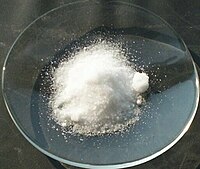
Photo from wikipedia
Abstract Deep geological repository (DGR) is one of the internationally accepted options to dispose radioactive wastes. Bentonite formations from Almeria, Spain, were selected as reference material for artificial barriers for… Click to show full abstract
Abstract Deep geological repository (DGR) is one of the internationally accepted options to dispose radioactive wastes. Bentonite formations from Almeria, Spain, were selected as reference material for artificial barriers for the future Spanish repository. However, the safety of this long-term disposal could be compromised not only by physicochemical factors but also by microbial processes. The highly radioactive waste must be safely stored at least for 100,000 years for the radioactivity to decrease to similar levels to those of natural uranium. To simulate a scenario where the mobilization of radionuclides from the repository to the host formations may occur, long-term microcosms were studied. After being exposed to uranyl nitrate for 5 months, the response of the bentonite microbial community to the addition of this radionuclide was evaluated. High throughput 16S rRNA gene sequencing revealed that the structure of the microbial community after the uranyl nitrate treatment differs to that of the control microcosms. The microbial diversity was dominated by Firmicutes and Proteobacteria. Moreover, after the uranyl nitrate treatment OTUs annotated as Paracoccus and Bacillus were highly enriched. The mineralogy of bentonites was not affected by the uranyl nitrate treatment as was demonstrated by X-ray diffraction analysis. In addition, the study of uranium-bacteria interaction revealed the ability of isolates to biomineralize uranium as uranium phosphate mineral phases. Thus, the changes induced by the release of uranium in the microbial population may also affect the mobility of this radionuclide, making it less mobile and therefore less harmful for this environment.
Journal Title: Applied Clay Science
Year Published: 2017
Link to full text (if available)
Share on Social Media: Sign Up to like & get
recommendations!